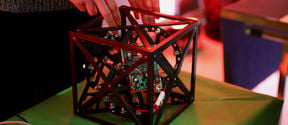Aalto-2 satellite is ready for space

Aalto-2 at Otaniemi. Photo: Tuomas Tikka
The Aalto-1, Finland's first satellite and completely student-realised, will see a continuation as Aalto-2 is now ready for space. Construction of the Aalto-2 satellite began in 2012, as a doctoral project, when the first students graduated as a Master’s of Science in Technology after working on the Aalto-1 project.
'The project aims to further develop the technologies and know-how initially developed in the Aalto-1 project. Aalto-1 and Aalto-2 are Aalto's next generation's tour de force in space technology,' responsible project leader, Assistant Professor Jaan Praks says happily.
Aalto-2 will take part in the international QB50 Mission, the aim of which is to produce the first ever comprehensive model of the features of the thermosphere, the layer between the Earth's atmosphere and space. A total of 50 nanosatellites will take part in the project, which will be launched as a satellite cluster on a low orbit. The satellites will spread rapidly across a large area on the orbit, and then less than half a year later fall into the Earth's atmosphere, where they will burn due to friction.
'Aalto-2 will be carrying the multi-Needle Langmuir Probe (mNLP) payload developed at the University of Oslo for the measurement of plasma characteristics. Our team's primary goal will be to demonstrate how well the satellite platform designed and built at Aalto University functions in challenging conditions of space,' Tuomas Tikka Project and Quality Manager for the Aalto-2 satellite explains.
Launch at the end of the year
The satellite's multi-stage journey from Otaniemi, Espoo to orbit will begin next week, when it is delivered to Dutch company Delft's Innovative Solutions in Space cleanroom. Final checks will be run on the satellite in the cleanroom after which it will be attached to the Nanorack's launch adapter. From there, its journey will continue to east coast of the United States to await the launch of the ATK's Antares rocket and the Cygnus cargo vessel to the ISS international space station. The launch is to take place the end of 2016.
'After the cargo arrives at the international space station, the launch adapter will be installed by astronauts to the robot arm. This will allow the satellite to be safely detached to the correct orbit. If the station's astronauts film the detachment, we will see Aalto 2- satellite once after we install it next week to the launch adapter,' Mr Tikka explains.
Dozens of students from Aalto University's different departments have participated in the design and construction of the satellite. The Aalto-2 satellite's Project and Quality Manager Tuomas Tikka, System Engineer Nemanja Jovanovic and System Designer Janne Kuhn will perform integration to the launch adapter in the Netherlands. Funding for the Aalto-2 project comes from Tekes and Aalto University.
Further information:
Aalto 2 satellite Project and Quality Manager Tuomas Tikka
[email protected]
Tel. + 358 50 436 9119
Assistant Professor Jaan Praks, project leader
Aalto University
[email protected]
Tel. + 358 50 420 5847
- Published:
- Updated:
Read more news

Aalto ARTS alum Vidha Samya’s artwork featured at the Venice Biennale 2024
The Pavilion of Finland presents ‘The pleasures we choose’ at the 60th International Art Exhibition – La Biennale di Venezia until 24 November 2024.
IoT Forge donates EUR 1 million to the School of Engineering
The donation will be used for research and education on the Industrial Internet and digital twins.
Join us for the first Aalto Open Science Award Ceremony
All Aaltonians are welcome – no registration required!